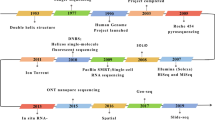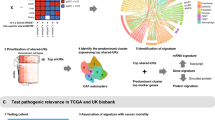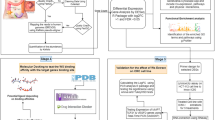Abstract
The current study was undertaken with a view to identify differential biomarkers in chewing-tobacco-associated oral cancer tissues in patients of Indian ethnicity. The gene expression profile was analyzed in oral cancer tissues as compared to clinically normal oral buccal mucosa. We examined 30 oral cancer tissues and 27 normal oral tissues with 16 paired samples from contralateral site of the patient and 14 unpaired samples from different oral cancer patients, for whole genome expression using high-throughput IlluminaSentrix Human Ref-8 v2 Expression BeadChip array. The cDNA microarray analysis identified 425 differentially expressed genes with >1.5-fold expression in the oral cancer tissues as compared to normal tissues in the oral cancer patients. Overexpression of 255 genes and downregulation of 170 genes (p < 0.01) were observed. Further, a minimum twofold overexpression was observed in 32 genes and downregulation in 12 genes, in 30–83 % of oral cancer patients. Biological pathway analysis using Kyoto Encyclopedia of Genes and Genome Pathway database revealed that the differentially regulated genes were associated with critical biological functions. The biological functions and representative deregulated genes include cell proliferation (AIM2, FAP, TNFSF13B, TMPRSS11A); signal transduction (FOLR2, MME, HTR3B); invasion and metastasis (SPP1, TNFAIP6, EPHB6); differentiation (CLEC4A, ELF5); angiogenesis (CXCL1); apoptosis (GLIPR1, WISP1, DAPL1); and immune responses (CD300A, IFIT2, TREM2); and metabolism (NNMT; ALDH3A1). Besides, several of the genes have been differentially expressed in human cancers including oral cancer. Our data indicated differentially expressed genes in oral cancer tissues and may identify prognostic and therapeutic biomarkers in oral cancers, postvalidation in larger numbers and varied population samples.


Similar content being viewed by others
References
Ferlay J, Steliarova-Foucher E, Lortet-Tieulent J. Cancer incidence and mortality patterns in Europe: estimates for 40 countries in 2012. Eur J Cancer. 2013;49:1374–403.
Bhatnagar R, Dabholkar J, Saranath D. Genome-wide disease association study in chewing tobacco associated oral cancers. Oral Oncol. 2013;48(9):831–5.
Subramanian SV, Nandy S, Kelly M, Gordon D, Smith GD. Patterns and distribution of tobacco consumption in India: cross sectional multilevel evidence from the 1998–9 national family health survey. BMJ. 2004;328:801.
Sankaranarayanan R, Swaminathan R, Brenner H, et al. Cancer survival in Africa, Asia, and Central America: a population-based study. Lancet Oncol. 2010;11(2):165–73.
Sasaki T, Moles DR, Imai Y, Speight PM. Clinico-pathological features of squamous cell carcinoma of the oral cavity in patients <40 years of age. J Oral Pathol Med. 2005;34(3):129–33.
Annertz K, Anderson H, Biörklund A, et al. Incidence and survival of squamous cell carcinoma of the tongue in Scandinavia, with special reference to young adults. Int J Cancer. 2002;10(1):95–9.
Kuriakose M, Sankaranarayanan M, Nair MK, et al. Comparison of oral squamous cell carcinoma in younger and older patients in India. Eur J Cancer B Oral Oncol. 1992;28(2):113–20.
Molinolo AA, Hewitt SM, Amornphimoltham P, et al. Dissecting the akt/mTOR signalling network: emerging results from the head and neck cancer tissue array initiative. Clin Cancer Res. 2007;13(17):4694–973.
Rai R, Kulkarni V, Saranath D. Genome wide instability scanning in chewing- tobacco associated oral cancer using inter-simple sequence repeat PCR. Oral Oncol. 2004;40(10):1033–9.
Rai R, Kulkarni V, Saranath D. Concurrent hypermethylation of multiple regulatory genes in chewing associated oral squamous cell carcinomas and adjacent normal tissues. Oral Oncol. 2003;40(2):145–53.
Saranath D. Integrated biology and molecular pathology of oral cancer. In: Contemporary Issues in Oral Cancer. Oxford; 2000.
Balmain A, Barrett JC, Moses H, Renan MJ. How many mutations are required for tumorigenesis? Implications from human cancer data. Mol Carcinog. 1993;7:139–46.
Saranath D, Bhoite L, Madhav G. Molecular lesions in human oral cancer: the Indian scene. Eur J Cancer B Oral Oncol. 1993;29(2):107–12.
McKay JD, Truong T, Gaborieau V, et al. A genome-wide association study of upper aerodigestive tract cancers conducted within the INHANCE consortium. PLoS Genet. 2011;7(3):e1001333.
Saintigny P, Zhang L, Fan YH, et al. Gene expression profiling predicts the development of oral cancer. Cancer Prev Res. 2011;4:218.
Estilo CL, Pornchai O, Talbot S, et al. Oral tongue cancer gene expression profiling: identification of novel potential prognosticators by oligonucleotide microarray analysis. BMC Cancer. 2009;9:11.
Severino P, Alvares AM, Michaluart P, et al. Global gene expression profiling of oral cancers suggests molecular heterogeneity within anatomic subsites. BMC Res Notes. 2008;1:113.
Belbin TJ, Singh B, Barber I, et al. Molecular classification of head and neck squamous cell carcinoma using cDNA microarrays. Cancer Res. 2002;62:1184–90.
Alevizos I, Mahadevappa M, Zhang X, et al. Oral cancer in vivo gene expression profiling assisted by laser capture microdissection and microarray analysis. Oncogene. 2001;20(43):6196–204.
Eisen MB, Spellman PT, Brown PO, Botstein D. Cluster analysis and display of genome-wide expression patterns. PNAS. 1998;95(25):14863–8.
Gene ontology consortium. http://www.geneontology.org/ Accessed 20 Nov 2014.
DAVID bioinformatics resources. http://david.abcc.ncifcrf.gov/ Accessed 20 Nov.
Kyoto encyclopedia of genes and genomes. http://www.genome.jp/kegg/ Accessed 20 Nov.
Genecards the human gene compendium. http://www.genecards.org/ Accessed 20 Nov.
National center for biotechnology information. http://www.ncbi.nlm.nih.gov/ Accessed 20 Nov.
Lai KC, Liu CJ, Chang KW, Lee TC. Enhanced expression of ASB6 and IFIT2 in oral squamous cell carcinoma. Proc Am Assoc Cancer Res. 2006;1:215.
Lai KC, Liu CJ, Chang KW, Lee TC. Depleting IFIT2 mediates atypical PKC signaling to enhance the migration and metastatic activity of oral squamous cell carcinoma cells. Oncogene. 2013;32:3686–97.
Ribeiro L, De Cassia GA, Cunha Q, Leles R, Batista C. Dual role of CCL3/CCR1 in oral squamous cell carcinoma: implications in tumor metastatis and local host defense. Oncol Rep. 2007;18:1107–13.
Worsham MJ, Stephen JK, Lu M, et al. Disparate molecular, histopathology, and clinical factors in HNSCC racial groups. Otolaryngol Head Neck Surg. 2011;145(2):64.
Wikberg ML, Edin S, Lundberg IV, et al. High intratumoral expression of fibroblast activation protein (FAP) in colon cancer is associated with poorer patient prognosis. Tumor Biol. 2013;34(2):1013–20.
Dihlmann S, Tao S, Echterdiek F, et al. Lack of Absent in Melanoma 2 (AIM2) expression in tumor cells is closely associated with poor survival in colorectal cancer patients. Int. J. Cancer. 2014;135(10):2387–96.
Patsos G, Germann A, Gebert J, Dihlmann S. Restoration of absent in melanoma 2 (AIM2) induces G2/M cell cycle arrest and promotes invasion of colorectal cancer cells. Int J Cancer. 2010;126(8):1838–49.
Jia J, Martin TA, Ye L, Jiang WG. FAP-α (Fibroblast activation protein-α) is involved in the control of human breast cancer cell line growth and motility via the FAK pathway. BMC Cell Biol. 2014;15:16.
Rodrigues LR, Teixeira JA, Schmitt FL, Paulsson M, Lindmark-Mänsson H. The role of osteopontin in tumor progression and metastasis in breast cancer. Cancer Epidemiol Biomark Prev. 2007;16(6):1087–97.
Kretschmer C, Sterner-Kock A, Siedentopf F, Schoenegg W, Schlag PM, Kemmner W. Identification of early molecular markers for breast cancer. Mol Cancer. 2011;10(1):15.
Zhang H, Liu HB, Yuan DM, Wang ZF, Wang YF, Song Y. Prognostic value of secreted phosphoprotein-1 in pleural effusion associated with non-small cell lung cancer. BMC Cancer. 2014;14(1):280.
Tang SW, Yang TC, Lin WC, Chang WH, Wang CC, Lai MK, Lin JY. Nicotinamide N-methyltransferase induces cellular invasion through activating matrix metalloproteinase-2 expression in clear cell renal cell carcinoma cells. Carcinogenesis. 2011;32(2):138–45.
Ruano Y, Mollejo M, Ribalta T, et al. Identification of novel candidate target genes in amplicons of Glioblastoma multiforme tumors detected by expression and CGH microarray profiling. Mol cancer. 2006;5(1):39.
Kashyap MK, Marimuthu A, Kishore CJ, et al. Genomewide mRNA profiling of esophageal squamous cell carcinoma for identification of cancer biomarkers. Cancer Biol Ther. 2009;8(1):1–11.
Botton T, Puissant A, Cheli Y. Ciglitazone negatively regulates CXCL1 signaling through MITF to suppress melanoma growth. Cell Death Differ. 2011;18(1):109–21.
Sabatier R, Finetti P, Adelaide J, et al. Down-regulation of ECRG4, a candidate tumor suppressor gene, in human breast cancer. PLoS One. 2011;6(11):e27656.
Yu J, Bulk E, Ji P. The EPHB6 receptor tyrosine kinase is a metastasis suppressor that is frequently silenced by promoter DNA hypermethylation in non–small cell lung cancer. Clin Cancer Res. 2010;16(8):2275–83.
Acknowledgments
The authors gratefully acknowledge the support for the project from Reliance Life Science Pvt. Ltd, Dhirubhai Ambani Life Sciences Center, Navi Mumbai, India.
Conflict of interest
No potential conflicts of interest are disclosed.
Author information
Authors and Affiliations
Corresponding author
Electronic supplementary material
Below is the link to the electronic supplementary material.
Rights and permissions
About this article
Cite this article
Chakrabarti, S., Multani, S., Dabholkar, J. et al. Whole genome expression profiling in chewing-tobacco-associated oral cancers: a pilot study. Med Oncol 32, 60 (2015). https://doi.org/10.1007/s12032-015-0483-4
Received:
Accepted:
Published:
DOI: https://doi.org/10.1007/s12032-015-0483-4




